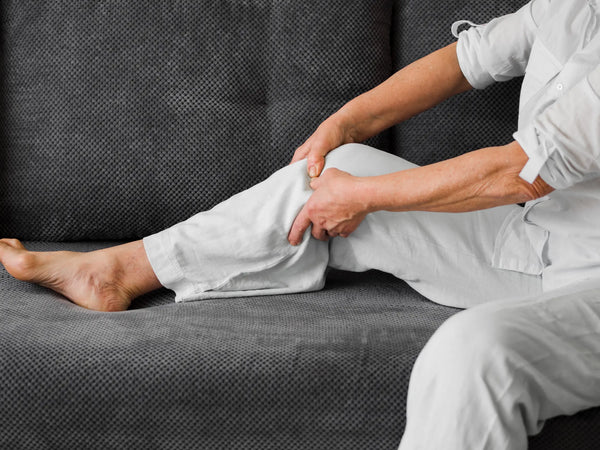-
Gout, often mistaken for other conditions due to similar symptoms, requires accurate diagnosis for effective management.
-
Conditions like pseudogout, rheumatoid arthritis, osteoarthritis, septic arthritis, and bursitis share symptoms with gout but have distinct causes and treatments.
-
The differentiation between gout and other joint conditions hinges on diagnostic tests, including joint fluid analysis and blood tests.
-
Effective management of gout focuses on lowering uric acid levels through medication and lifestyle changes, while other conditions require targeted treatments based on their specific causes.
-
Accurate diagnosis and early treatment are crucial in preventing joint damage and ensuring the best possible outcomes for individuals experiencing joint pain.
Gout is often mistaken for other conditions due to its similar symptoms. This inflammatory arthritis is caused by the accumulation of uric acid crystals within the joint, leading to sudden and severe attacks of pain, especially in the big toe.1
The complexity of joint symptoms and the broad spectrum of diseases with overlapping signs often challenge accurate diagnosis. Understanding the nuances of gout, including its common and atypical presentations, is crucial for distinguishing it from other conditions that mimic its symptoms.
This article looks into several conditions that can be mistaken for gout, such as pseudogout, rheumatoid arthritis, and others, highlighting the importance of accurate diagnosis and appropriate management strategies.

What Other Conditions Can Be Mistaken For Gout?
The presentation of gout can closely resemble that of various other joint disorders, leading to potential misdiagnosis.
Conditions such as pseudogout, rheumatoid arthritis, osteoarthritis, septic arthritis, and bursitis share symptoms with gout, including joint pain, swelling, and redness.
These similarities can complicate the diagnostic process, delaying proper treatment and relief for patients.
Pseudogout
Pseudogout, formally known as calcium pyrophosphate deposition disease (CPPD), is a prime example of a condition frequently confused with gout.2
Both gout and pseudogout are forms of crystal arthritis caused by the deposition of crystals in the joints. However, the type of crystals differs, uric acid crystals in gout and calcium pyrophosphate dihydrate crystals in pseudogout.
Pseudogout commonly affects the knee and other larger joints, such as the wrists, shoulders, and hips, distinguishing it from gout, which most commonly targets the big toe.
Despite these differences, the symptoms of pseudogout—sudden, severe pain, swelling, tenderness, redness, and warmth at the affected joint—mirror those of a gout attack, making clinical differentiation challenging without detailed analysis of the joint fluid for specific crystal types.
Rheumatoid Arthritis
Rheumatoid arthritis (RA) is another inflammatory disease that can be mistaken for gout, particularly in cases of polyarticular gout, which affects several joints simultaneously. Unlike gout, which is triggered by urate crystals, RA is an autoimmune condition that results in chronic inflammation of the joints.3
Symptoms of RA include joint pain, swelling, stiffness, and loss of function, often occurring in a symmetrical pattern (affecting both sides of the body equally). The presence of specific blood markers, such as anti-CCP antibodies, rheumatoid factor (RF), C-reactive protein (CRP), and elevated erythrocyte sedimentation rate (ESR), can help differentiate RA from gout.
Additionally, RA can cause rheumatoid nodules and lead to joint damage over time, further complicating the distinction from gout without thorough diagnostic testing.

Osteoarthritis
Osteoarthritis (OA), a degenerative joint disease, is commonly confused with gout due to overlapping symptoms such as joint pain and stiffness. OA is characterized by the breakdown of cartilage, the cushioning material at the end of bones, leading to bone rubbing on bone, which can cause pain, swelling, and reduced joint mobility.4
Unlike gout, which is caused by the accumulation of uric acid crystals, OA results from wear and tear and aging, affecting the knees, hips, hands, and spine most frequently.
OA's gradual onset and the absence of urate crystals in joint fluid help differentiate it from gout, emphasizing the need for comprehensive diagnostic evaluation to ensure accurate diagnosis and treatment.
Septic Arthritis
Septic arthritis, an infection within the joint space, presents with symptoms that can closely mimic those of a gout attack, including severe joint pain, swelling, redness, and warmth.
Septic arthritis is caused by bacterial, viral, or fungal pathogens invading the joint, leading to a rapid onset of symptoms and often accompanied by fever and chills—signs that are not typical of gout. Diagnosis involves aspirating joint fluid to identify the causative pathogen through culture.5
Immediate treatment is critical in septic arthritis to prevent joint damage and systemic spread of the infection. Differentiating septic arthritis from gout is crucial, as the treatment approaches differ significantly, with antibiotics being central to managing septic arthritis.
Bursitis
Bursitis refers to the inflammation of the bursae, small fluid-filled sacs that cushion bones, tendons, and muscles near joints. Bursitis often presents with symptoms similar to those of gout, such as joint pain, swelling, and tenderness, especially in areas like the elbow, knee, shoulder, and hip.6
Unlike gout, which is triggered by the accumulation of urate crystals within the joint, bursitis is usually caused by repetitive motions or positions that put pressure on the bursae around a joint.
The distinction between gout and bursitis primarily lies in the location of the discomfort—bursitis affects the protective sacs outside the joint, whereas gout affects the joint itself.
Diagnostic imaging and analysis of bursa fluid can help differentiate bursitis from gout by ruling out the presence of urate crystals.

Diagnostic Challenges
Diagnosing gout poses several challenges, primarily due to its symptom overlap with conditions like pseudogout, rheumatoid arthritis, osteoarthritis, septic arthritis, and bursitis. The "great imitator" nature of gout, capable of presenting with a variety of symptoms across different joints, complicates the clinical picture.
Key to overcoming these challenges is a comprehensive diagnostic approach that includes patient history, physical examination, blood tests to measure uric acid levels and other relevant markers, joint fluid analysis to identify urate crystals, and advanced imaging techniques like ultrasound or dual-energy CT scans. These methods collectively enable healthcare providers to distinguish gout from its mimics accurately.7
Despite advancements in diagnostic tools, the variability in individual responses to excess uric acid and the possibility of concurrent conditions necessitate a careful, individualized approach to diagnosis and treatment.
How to Manage Misdiagnosed Conditions
Misdiagnosis can lead to ineffective treatment plans and prolonged discomfort for patients.8 Once a misdiagnosis is identified, it's crucial to adjust the management strategy to target the correct underlying condition.
For conditions like pseudogout, rheumatoid arthritis, osteoarthritis, septic arthritis, and bursitis, treatment may involve a combination of medication, lifestyle adjustments, physical therapy, and, in severe cases, surgery.
It's essential to address the root cause of the condition, whether it's crystal deposits, autoimmune responses, wear and tear, infection, or inflammation of the bursae.
Managing misdiagnosed conditions effectively requires a patient-specific approach that considers all aspects of the individual's health, including concurrent conditions that may influence treatment outcomes.
When It’s Not Gout
When joint symptoms are determined not to be caused by gout, treatment should be tailored to the specific diagnosed condition. For example, osteoarthritis management may focus on pain relief, maintaining joint mobility, and minimizing further joint damage through weight management, physical therapy, and possibly joint replacement surgery in advanced cases.
In contrast, managing rheumatoid arthritis involves immune system modulation to reduce inflammation and prevent joint damage. Treatment may include disease-modifying antirheumatic drugs (DMARDs) and biologic agents.
Understanding the correct diagnosis ensures that patients receive the most appropriate and effective treatment, highlighting the importance of accurate and thorough evaluation of joint symptoms.

Confirmed Gout
For confirmed cases of gout, managing uric acid levels becomes the cornerstone of treatment to prevent future gout attacks and minimize joint damage.1
Medications such as xanthine oxidase inhibitors (e.g., allopurinol) and uricosurics (e.g., probenecid) may be prescribed to reduce uric acid production or increase its excretion.
Lifestyle modifications, including dietary changes to avoid foods rich in purines and reducing alcohol intake, particularly beer, can also help manage uric acid levels.
In the case of an acute gout attack, nonsteroidal anti-inflammatory drugs (NSAIDs), colchicine, and corticosteroids may provide pain relief and reduce inflammation.
When to Seek Medical Advice
Seeking medical advice is crucial whenever new, unexplained joint symptoms arise, especially if they're severe, sudden, or accompanied by systemic symptoms like fever.
Additionally, individuals with a history of gout or those at risk should consult healthcare providers if they notice changes in the frequency, intensity, or location of joint pain, which might indicate uncontrolled uric acid levels or the presence of another condition.
Early intervention and accurate diagnosis are key to preventing joint damage and managing symptoms effectively, whether it's gout or another condition mimicking its presentation.

Conclusion: Navigating the Complexities of Gout and Similar Conditions
Understanding the complexities of gout and its mimics is crucial in navigating the path to an accurate diagnosis and effective management plan. While gout shares symptoms with several other joint conditions, distinguishing between these can prevent misdiagnosis and ensure appropriate treatment.
For those diagnosed with gout, managing uric acid levels and adopting lifestyle changes are fundamental steps in minimizing the risk of future attacks and joint damage. However, when joint symptoms are not attributable to gout, targeted treatment for the correctly diagnosed condition is essential.
Regardless of the diagnosis, seeking timely medical advice is critical in achieving the best possible outcomes, underscoring the importance of comprehensive evaluation and personalized care in managing joint health.
Frequently Asked Questions
What is the main difference between gout and pseudogout? The main difference lies in the type of crystals that form in the joints: gout involves uric acid crystals, while pseudogout involves calcium pyrophosphate dihydrate crystals.
Can rheumatoid arthritis be confused with gout? Yes, rheumatoid arthritis can be confused with gout due to overlapping symptoms like joint pain and swelling, but blood tests for specific markers can help differentiate the two.
What are the key symptoms of septic arthritis that differentiate it from gout? Septic arthritis symptoms include severe joint pain accompanied by fever and chills, indicating an infection, unlike gout, which does not typically cause fever.
How can lifestyle changes help manage confirmed gout? Lifestyle changes, such as reducing intake of high-purine foods and alcohol, can help manage gout by lowering uric acid levels in the body.
When should someone seek medical advice for joint pain? Medical advice should be sought whenever new, severe, or sudden joint pain occurs, especially if accompanied by fever or if existing joint pain worsens or changes in character.
Medical Disclaimer:
The information provided in this article is for educational and informational purposes only and should not be considered a substitute for professional medical advice, diagnosis, or treatment. Please consult with your healthcare provider before starting any new dietary supplement, especially if you are pregnant, nursing, have a medical condition, or are taking other medications. Never disregard professional medical advice or delay in seeking it because of something you have read in this article.
References:
-
Ragab, G., Elshahaly, M., & Bardin, T. (2017). Gout: An old disease in new perspective - A review. Journal of advanced research, 8(5), 495–511. https://doi.org/10.1016/j.jare.2017.04.008
-
Macmullan, P., & McCarthy, G. (2012). Treatment and management of pseudogout: insights for the clinician. Therapeutic advances in musculoskeletal disease, 4(2), 121–131. https://doi.org/10.1177/1759720X11432559
-
Chauhan K, Jandu JS, Brent LH, et al. Rheumatoid Arthritis. [Updated 2023 May 25]. In: StatPearls [Internet]. Treasure Island (FL): StatPearls Publishing; 2024 Jan-. Available from: https://www.ncbi.nlm.nih.gov/books/NBK441999/
-
Sen R, Hurley JA. Osteoarthritis. [Updated 2023 Feb 20]. In: StatPearls [Internet]. Treasure Island (FL): StatPearls Publishing; 2024 Jan-. Available from: https://www.ncbi.nlm.nih.gov/books/NBK482326/
-
Momodu II, Savaliya V. Septic Arthritis. [Updated 2023 Jul 3]. In: StatPearls [Internet]. Treasure Island (FL): StatPearls Publishing; 2024 Jan-. Available from: https://www.ncbi.nlm.nih.gov/books/NBK538176/
-
InformedHealth.org [Internet]. Cologne, Germany: Institute for Quality and Efficiency in Health Care (IQWiG); 2006-. Bursitis: Overview. 2018 Jul 26. Available from: https://www.ncbi.nlm.nih.gov/books/NBK525773/
-
Abhishek, A., Roddy, E., & Doherty, M. (2017). Gout - a guide for the general and acute physicians. Clinical medicine (London, England), 17(1), 54–59. https://doi.org/10.7861/clinmedicine.17-1-54

